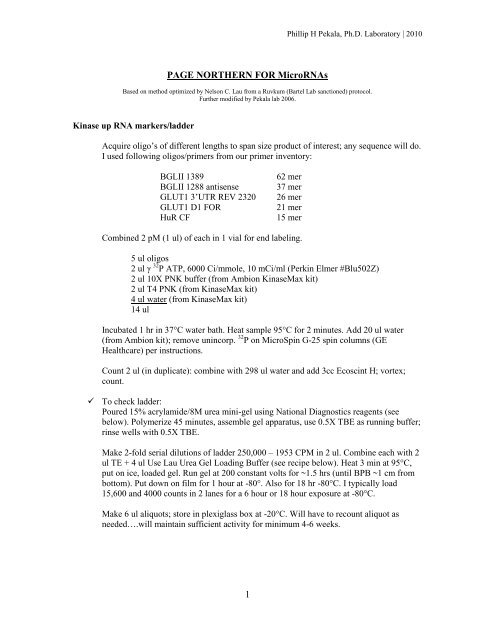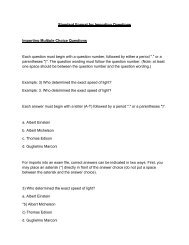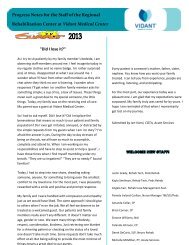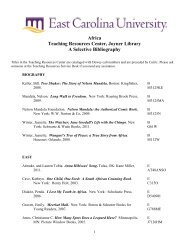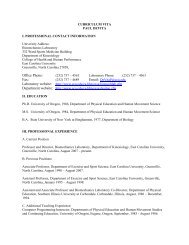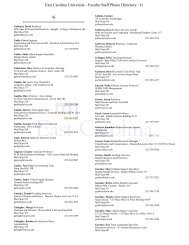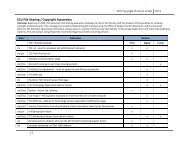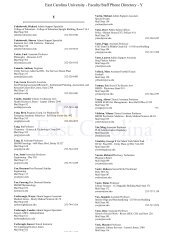Bartel/Lau 8M Urea Loading Buffer
Bartel/Lau 8M Urea Loading Buffer
Bartel/Lau 8M Urea Loading Buffer
Create successful ePaper yourself
Turn your PDF publications into a flip-book with our unique Google optimized e-Paper software.
Phillip H Pekala, Ph.D. Laboratory | 2010<br />
PAGE NORTHERN FOR MicroRNAs<br />
Based on method optimized by Nelson C. <strong>Lau</strong> from a Ruvkum (<strong>Bartel</strong> Lab sanctioned) protocol.<br />
Further modified by Pekala lab 2006.<br />
Kinase up RNA markers/ladder<br />
Acquire oligo’s of different lengths to span size product of interest; any sequence will do.<br />
I used following oligos/primers from our primer inventory:<br />
BGLII 1389<br />
BGLII 1288 antisense<br />
GLUT1 3’UTR REV 2320<br />
GLUT1 D1 FOR<br />
HuR CF<br />
62 mer<br />
37 mer<br />
26 mer<br />
21 mer<br />
15 mer<br />
Combined 2 pM (1 ul) of each in 1 vial for end labeling.<br />
5 ul oligos<br />
2 ul γ 32 P ATP, 6000 Ci/mmole, 10 mCi/ml (Perkin Elmer #Blu502Z)<br />
2 ul 10X PNK buffer (from Ambion KinaseMax kit)<br />
2 ul T4 PNK (from KinaseMax kit)<br />
4 ul water (from KinaseMax kit)<br />
14 ul<br />
Incubated 1 hr in 37°C water bath. Heat sample 95°C for 2 minutes. Add 20 ul water<br />
(from Ambion kit); remove unincorp. 32 P on MicroSpin G-25 spin columns (GE<br />
Healthcare) per instructions.<br />
Count 2 ul (in duplicate): combine with 298 ul water and add 3cc Ecoscint H; vortex;<br />
count.<br />
To check ladder:<br />
Poured 15% acrylamide/<strong>8M</strong> urea mini-gel using National Diagnostics reagents (see<br />
below). Polymerize 45 minutes, assemble gel apparatus, use 0.5X TBE as running buffer;<br />
rinse wells with 0.5X TBE.<br />
Make 2-fold serial dilutions of ladder 250,000 – 1953 CPM in 2 ul. Combine each with 2<br />
ul TE + 4 ul Use <strong>Lau</strong> <strong>Urea</strong> Gel <strong>Loading</strong> <strong>Buffer</strong> (see recipe below). Heat 3 min at 95°C,<br />
put on ice, loaded gel. Run gel at 200 constant volts for ~1.5 hrs (until BPB ~1 cm from<br />
bottom). Put down on film for 1 hour at -80°. Also for 18 hr -80°C. I typically load<br />
15,600 and 4000 counts in 2 lanes for a 6 hour or 18 hour exposure at -80°C.<br />
Make 6 ul aliquots; store in plexiglass box at -20°C. Will have to recount aliquot as<br />
needed….will maintain sufficient activity for minimum 4-6 weeks.<br />
1
Phillip H Pekala, Ph.D. Laboratory | 2010<br />
Running the Gel<br />
Make up 15% PAGE (National Diagnostics Sequagel Mix) using ATTO apparatus and minigels<br />
(1 mm thickness).<br />
Clean plates well. Siliconizing plates optional; I found it wasn’t necessary. Assemble gel<br />
apparatus.<br />
15% PAGE – 30 ml from Sequagel Mix<br />
18ml Concentrate<br />
240 ul 10% APS<br />
9 ml Diluent 12 ul TEMED<br />
3 ml <strong>Buffer</strong><br />
Prepare samples of 20-30 ug total RNA (volume of 10 ul or less) mixed with at least 8 ul of<br />
<strong>Bartel</strong> Lab <strong>8M</strong> <strong>Urea</strong> <strong>Loading</strong> <strong>Buffer</strong> (see recipe). Heat samples in 80°C heating block (5S-11<br />
on high) for 5-10 mins, spin down, and use a beveled tip to load gel after urea from lanes<br />
have been washed out again. Run gel at 200 V for 30 min to 1 hr (allows RNA’s large and<br />
small to “gently” enter gel) and then raise voltage to 400 V for 30 min – 1 hr, until the BPB<br />
dye just runs off the gel (Xylene cyanol should still be in the middle of the gel). Use 0.5x<br />
TBE for running buffer.<br />
Separate gel onto Saran Wrap, stain with 4 ug/ml EtBr (1:2500 of 10mg/ml stock) in 25 ml<br />
0.5x TBE for 5 min, and look for tRNA and 5S rRNA bands (78 and 120 nt) for quality of<br />
RNA prep and for visual loading control. Take digital picture on Shewchuk’s camera and<br />
save image.<br />
Transfer Gel to Membrane<br />
Cut Nylon Membrane (Genescreen Plus from Perkin Elmer) size of gel; cut 2 sheets of 3mm<br />
Whatman Chromotography filter paper to fit semi-dry transfer apparatus (was a package of<br />
precut filter paper in drawer 5S-11 with Genescreen Plus membranes). Presoak membrane<br />
and filter paper in 0.5x TBE.<br />
Assemble the Ideal Genie Electrophoretic Semi-Dry Blotter per instructions in order listed<br />
inside the tray:<br />
1. cathode plate (banana connector should be in upper left) on bottom<br />
2. bubble screen<br />
3. Scotch-Brite pad presoaked in 0.5x TBE (add 0.5x TBE to level even with Scotch-<br />
Brite pad)<br />
4. piece of filter paper presoaked in 0.5x TBE<br />
5. prewetted Genescreen Plus membrane<br />
6. place gel on top of membrane<br />
7. prewetted filter paper (roll cut plastic pipette along gel sandwich to flatten and drive<br />
out bubbles)<br />
8. Scoth-Brite pad presoaked in 0.5x TBE<br />
9. bubble screen<br />
10. anode plate (banana connector should be in upper right)<br />
2
Phillip H Pekala, Ph.D. Laboratory | 2010<br />
11. plastic 2-hole cover on top<br />
Keeping tray level, slide the tray into tray holder. The sandwich should need to be<br />
compressed about 2 mm to slide into holder. If not, another Scotch-Brite pad should be added<br />
to the sandwich. Slowly tip the Genie to its vertical running position. Add buffer it it appears<br />
final buffer level will not cover the blotting area (of gel).<br />
Connect Genie to power supply and begin blotting. Left-hand connection is (+) anode, righthand<br />
connection is (-) cathode (because the membrane is BEHIND the gel here requires the<br />
positive plate to be on the bottom so nucleic acids will move from front to back…run to red).<br />
Transfer at constant current (200 mA) for about 1 hr, 15 min.<br />
Remove gel from sandwich; do not separate gel from membrane. Use a syringe needle to<br />
mark the lanes on the membrane by punching small holes through top of membrane. May<br />
save the gel, restain with EtBr and take a picture to be sure all the RNA’s
Phillip H Pekala, Ph.D. Laboratory | 2010<br />
2 ul 10 uM oligo (~20 mer, 20 pmoles)<br />
2 ul 10X T4 PNKinase <strong>Buffer</strong> (KinaseMax kit from Ambion)<br />
30 uCi γ 32 P ATP, 6000 Ci/mmole, 10 mCi/ml (Perkin Elmer #Blu502Z)<br />
1 ul T4 Poly Nucleotide Kinase (Ambion kit)<br />
DEPC water to bring to 20 ul (Ambion kit)<br />
Incubate 1 hr, 37°C water bath.<br />
Kill Kinase 10 min, 68°C (5S-11 heat block, low setting)<br />
Add 30 ul water (Ambion kit) to heat-inactivated labeling reaction. Remove 0.5 ul to<br />
scintillation vial containing 295 ul TE; set aside. Purify probe from unincorporated label with<br />
Microspin G-25 columns (GE Healthcare). Follow manufacturer’s instructions. After<br />
purification, remove 2 ul to a second scintillation vial containing 298 ul TE. Add 3 cc<br />
Ecoscint H to each scintillation vial, vortex well and count. Calculate CPM/ul; expect<br />
between 33% and 50% incorporation.<br />
Determine amount of labeled probe to add to blot; want 1.5 – 2 x 10 7 CPM total.<br />
3. Hybridization<br />
Dump the Prehyb solution from bottle/blot. Prepare an additional 25 ml Prehyb/Hyb solution<br />
that is warm (50°C) and contains 1 mg denatured (heat 100°C, 5 min) sheared salmon sperm<br />
DNA. Add to blot, and now add correct amount of purified labeled probe to bottle. Discard<br />
any unused probe. Close tightly and rotate in hyb oven at 50°C overnight. Meanwhile,<br />
prepare the following wash solutions:<br />
Non-Stringent Wash Solution – 160 ml per blot (40 ml per wash for 4 washes) Store in 500 ml<br />
bottles.<br />
Final: Start: 200ml (>one blot) 500ml(>three blots)<br />
3X SSC 20X 30ml 75ml<br />
25mM NaH 2 PO 4 pH 7.5 1M 5ml 12.5ml<br />
5% SDS 20% 50ml 125ml<br />
10X Denhardt’s Solution 100X 20ml 50ml<br />
dH 2 O (DEPC not necessary) 95ml 240ml<br />
Stringent Wash Solution – 80 ml per blot (1 wash only) Store in 500ml bottles<br />
Final: Start: 200ml (>one blot) 500ml(>three blots)<br />
1X SSC 20X 10ml 25ml<br />
1% SDS 20% 10ml 25ml<br />
dH 2 O 180ml 450ml<br />
Place bottles in 50°C oven to warm up overnight and to get the SDS to dissolve back into<br />
solution.<br />
4
Phillip H Pekala, Ph.D. Laboratory | 2010<br />
Washing and Exposing<br />
All washes to be done at 50°C. Dump hot hybridization solution into designated radioactive<br />
liquid waste container. Add 40 ml Non-Stringent Wash to each bottle. Cap and rotate in<br />
Hyb Oven for 10 min. Dump this first wash also in radioactive liquid waste container.<br />
Repeat Non-stringent wash, 40 ml, 10 min. Dump this second wash down the sink.<br />
Repeat Non-Stringent Wash, 40 ml for 30 min, dump; repeat 30 min wash. Dump wash in<br />
sink. Finally, wash once with Stringent Wash, 80 ml, 5 min.<br />
Seal blot in Kapak Heat-Seal bag. Stick sealed blots RNA side up in film cassette and<br />
expose film 6 hrs and/or overnight -80°C.<br />
Stripping a Northern Blot Protocol<br />
Wash blot in 80ml 1% SDS at 85°C for 30 minutes, rotating (easiest to use hyb oven). You<br />
can add an additional wash if desired, and thus shorten each wash to 10 minutes, but be<br />
liquid is prewarmed to 85°C.<br />
When using GeneScreen Plus Nylon and doing correct UV crosslinking and baking, RNA<br />
can be quite hardy on these blots, so multiple washes can be done with very minor loss of<br />
signal. Do avoid excessive wrinkling of the blot or letting it dry out before complete<br />
stripping of blot.<br />
After stripping, heat-seal blot in Kapak bag and expose film for 18 hours -80°C to ensure<br />
probe has been stripped. Store in Kapak-sealed bag, either at room temp or at -20°C (we<br />
have also successfully stored sealed blots at 4°C). Blots have pretty long shelf life (couple of<br />
months) but your 32 P ladder marker may decay out.<br />
5
Phillip H Pekala, Ph.D. Laboratory | 2010<br />
REAGENTS AND BUFFERS FOR<br />
PAGE NORTHERNS (MICRO RNA ASSAY)<br />
<strong>Bartel</strong>/<strong>Lau</strong> <strong>8M</strong> <strong>Urea</strong> <strong>Loading</strong> <strong>Buffer</strong><br />
Makes 50 ml:<br />
24 g urea<br />
2 ml 0.5 M EDTA, pH 8.0<br />
0.1 ml 1M Tris, pH 7.5<br />
q.s. to 50 ml with dH 2 O (nuclease-free not necessary)<br />
*Check pH (7.5) but is usually ok. Filter-sterilize and store at 4°C.<br />
To use: combine 1 ml of <strong>8M</strong> <strong>Urea</strong> <strong>Loading</strong> <strong>Buffer</strong> + 12 ul of xylene cyanol dye stock and<br />
4 ul of bromophenol blue dye stock.<br />
Dye Stocks:<br />
Xylene cyanol: dissolve 140 mg in 1 ml <strong>8M</strong> <strong>Urea</strong> <strong>Loading</strong> buffer; store @ RT.<br />
Bromophenol blue: Dissolve 140 mg in 1 ml <strong>8M</strong> <strong>Urea</strong> <strong>Loading</strong> buffer; store @ RT.<br />
100x Denhardts Solution:<br />
To 200 ml nuclease-free water, add:<br />
5 g ficoll (Sigma #F2637)<br />
5 g polyvinylpyrrolidone (Sigma #PVP10-100G)<br />
5 g fatty acid-free BSA (Sigma #A6003-10G)<br />
Stir to dissolve. Ficoll may take a while. Q.S. to 250 ml with water.<br />
Filter sterilize (do not autoclave).<br />
Store in 25 ml aliquots in Abyss @ -80°C.<br />
1 M Na 2 HPO 4 , pH 7.5 MW of anhydrous Na 2 HPO 4 = 142<br />
Add 14.2 g/ 90 ml nuclease-free water<br />
pH to 7.5.<br />
q.s. to 100 ml with water.<br />
Filter sterilize. Store @ RT.<br />
1 M Tris, pH 7.5 Trizma base MW = 121.1<br />
Add 12.1 g to 90 ml nuclease-free water.<br />
6
Phillip H Pekala, Ph.D. Laboratory | 2010<br />
Correct pH to 7.5. Q.S. to 100 ml with water.<br />
Filter sterilize. Store @ RT.<br />
0.5 M EDTA Dihydrous MW = 372.2<br />
Add 93.05 g to 450 ml water while stirring.<br />
Add few drops of 10 N NaOH to ease into solution.<br />
Q.S. to 500 ml with water. Filter sterilize. Store @ RT.<br />
20x SSC<br />
(3 M NaCl, 0.3 M NaCitrate)<br />
Makes 1 liter<br />
Add to 800 ml dH 2 O:<br />
175.3 g NaCl<br />
88.2 g NaCitrate dihydrate (MW 294) OR 57.6 g citric acid (MW 192)<br />
pH to 7.0 w/ 1 N HCl. Q.S. to 1 L with water. Filter sterilize. Store @ RT.<br />
20% SDS<br />
Add 50 g SDS to 200 ml nuclease-free water.<br />
Stir until dissolved (can heat slightly on hot plate while stirring to hasten).<br />
Filter -sterilize. Store @ RT.<br />
7
8<br />
Phillip H Pekala, Ph.D. Laboratory | 2010


